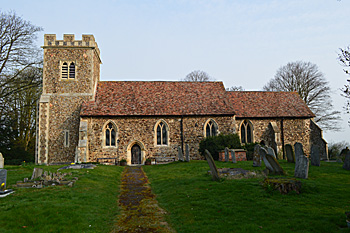The Community of Higham Gobion in General

The road to Higham Gobion looking north-east, April 2015
Landscape
Higham Gobion church stands on a hill at a height of 235 feet above sea-level. This hill, or ridge runs roughly north to south and the former parish lay east and west of this on lower ground. Most of the solid, or underlying geology is of a type called West Melbury Marly Chalk Formation, a sedimentary rock laid down between 99 and 112 million years ago in the warm, shallow seas of the Cretaceous Period. Along Higham Road south-west of its junction with the road to Hexton Common is a patch of Gault Formation – a mudstone laid down between 94 and 99 million years ago, still in the Cretaceous Period. The chalky soil is tempered in the north by glaciofluvial deposits of sand and gravel laid down up to two million years ago during Ice Ages.

Higham Gobion church from the south, April 2015
Administrative History
Higham Gobion was an ancient parish in the Flitt Hundred. On 1st April 1985 the civil parish was abolished and Higham Gobion became a hamlet in the civil parish of Shillington. The ecclesiastical parish continues, though the living is held in plurality [2015] with Barton-le-Clay and Hexton [Hertfordshire].
The ancient parish had a major outlier around Faldo Farm and two minor outliers which were all transferred to the civil parish of Pulloxhill in 1933. The area around Faldo Farm was transferred to Barton-le-Clay in 1984 [ref: CDP81].

Name
Higham means high farm, or homestead, which is appropriate for that portion of the parish on the hill. The Gobion element is the name of the family who held the manor in the early Middle Ages. Over time the name has undergone a few variations as seen below:
- 1086: Echam;
- 1166: Heham;
- 1231: Hecham;
- 1287: Hegham;
- 1291: Heygham Gobyon;
- c.1520: Higham Gubyns;
- 1526: Higham Gubion;
- 1595: Higham Gubbin or Higham Gubbins.

Westhey Manor April 2015
Population
The Domesday Book of 1086 states that the manor contained 14 villagers, 2 smallholders and 5 slaves. These 21 people were heads of household so to arrive at a true figure one should probably multiply this by a factor of at least four. This suggests a population of 84 or so – far higher than today's figure. Until absorbed by Shillington in 1985 census returns gave the following figures for the population of Higham Gobion:
- 1801: 91;
- 1811: 113;
- 1821: 86;
- 1831: 108;
- 1841: 109;
- 1851: 134;
- 1861: 121;
- 1871: 100;
- 1881: 121;
- 1891: 73;
- 1901: 59;
- 1911: 76;
- 1921: 59;
- 1931: 62;
- 1951: 27;
- 1961: 28;
- 1971: 22;
- 1981: 24.